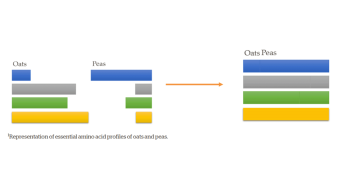June 1, 2021
Amino Acids

Amino acids are the building blocks of protein that are essential for the growth and maintenance of almost all tissues of the body including muscle, hair, bone, and organs. Protein from foods is broken down in the digestive tract to release amino acids which are then used to make body proteins for tissue maintenance and repair. It is the amino acids supplied by protein that are needed to meet the requirements of the animal, rather than the protein or meat.
Essential vs. Non-Essential Amino Acids
In total, there are 22 amino acids that pets require. Twelve of these, classified as non-essential amino acids, can be synthesized by pets. The remaining 10, which cannot be synthesized by the body, must be obtained through the diet, and therefore are called essential amino acids. It is important that diets formulated for pets contain adequate amounts of these essential amino acids to meet nutrient requirements.
Cats also require one extra amino acid-like compound, called taurine. Taurine is found naturally in animal-based ingredients and is also available as a supplement. It is critical for a cat’s normal heart, eye, and reproductive function. Because it plays such a critical role for health, it is often added to cat food.
Essential Amino Acids for Dogs and Cats
- *Arginine
- Histidine
- Isoleucine
- Leucine
- Lysine
- Methionine
- Phenylalanine
- Tryptophan
- Threonine
- Valine
- **Taurine
*Essential for dogs and cats, but not essential for many other adult animals.
**Essential for cats; may be conditionally essential for some dogs.
Different sources of protein and amino acids
Each protein source is unique in the amount and type of amino acids that it supplies. However, the structure of an amino acid is the same regardless of the protein source. In other words, the body does not differentiate between amino acids from plant sources or meat sources, and both are excellent options to provide protein to pets.
The ability of a protein to be used by the body is defined as its protein quality or biological value. Animal proteins are considered high quality proteins because they provide all of the essential amino acids in the correct amounts required by pets. Plant proteins are often lower in one or more essential amino acid (limiting amino acid), but this can easily be corrected by eating complementary plant protein sources. For example, oats and peas have different amino acid profiles that together provide all essential amino acids (figure1).

When amino acid requirements cannot be met using whole food ingredients alone, individual amino acids are available to be used as a supplement in the diet.
Because the environmental impact of producing animal protein is much higher than that of plant-based protein, formulating recipes using plant-based proteins in combination with moderate levels of animal protein is a sustainable way of meeting the amino acid requirements of pets.
This blog was originally published on August 17, 2020. Last revised June 2021.


